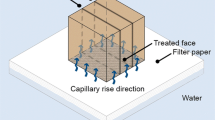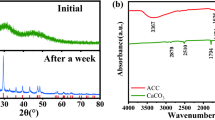Abstract
The effectiveness of using hydroxyapatite (HAP) as a consolidant for carbonate stones was evaluated. HAP was chosen as a consolidating agent since it is notably less soluble than calcite and has a similar crystal structure and a close lattice match to it. Among possible methods for forming HAP, the reaction between the calcite of the stone and a solution of diammonium hydrogen phosphate (DAP) in mild conditions was chosen. Indiana Limestone samples, artificially damaged by heating to 300°C for 1 hour, were treated with a 1 molar DAP solution by partial immersion and capillary absorption for 48 hours or by brushing until apparent refusal and wrapping with a plastic film for 48 hours. After washing in deionized water for 3 days and drying under a fan at room temperature until constant weight, the improvements in dynamic elastic modulus and tensile strength were evaluated. The formation of calcium phosphate phases was observed by scanning electron microscopy (SEM) and the phase characterization performed by energy dispersive X-ray spectroscopy (EDS) and electron back-scattered diffraction (EBSD). The water absorption modification after the consolidating treatment was then assessed. Results show that treated samples experienced significant increases in dynamic elastic modulus and tensile strength, as a consequence of crack reduction and pore filling consequent to HAP deposition at grain boundaries. The sorptivity of the treated samples is reduced by 26-44% (based on treatment technique), so that water and water vapor exchanges with the environment are not blocked.
Similar content being viewed by others
References
E.M. Winkler, Stone in architecture – Properties, durability (Springer, New York, 1997)
V. Daniele, G. Taglieri, R. Quaresima, J Cult Herit 9, 294–301 (2008)
G.W. Scherer, G.S. Wheeler, Key Engineering Materials 391, 1–25 (2009)
G. Wheeler, J. Mendez-Vivar, E.S. Goins, S.A. Fleming, C.J. Brinker, in Proceedings of 9th Int. Con. on the Deterioration and Conservation of Stone (Elsevier, Amsterdam, 2000) pp. 541–545
M. Favaro, R. Mendichi, F. Ossola, U. Russo, S. Simon, P. Tomasin, P.A. Vigato, Polym Degrad Stabil 91, 3083–3096 (2006)
S. Vicini, S. Margutti, G. Moggi, E. Pedemonte, J Cult Herit 2, 143–147 (2001)
F. Cappitelli, P. Principi, R. Pedrazzani, L. Toniolo, C. Sorlini, Sci Total Environ 385, 172–181 (2007)
S.V. Dorozhkin, Materials 2, 399–498 (2009)
D.R. Lide (Ed.), CRC Handbook of Chemistry and Physics (The Chemical Rubber Co., 1999)
G. Boivin, Medicographia 29, 126–132 (2007)
A.J. Skinner, J.P. LaFemina, H.J.F.Hansen, Am Mineral 79, 205–214 (1994)
M. Mathew, S. Takagi, J Res Natl Inst Stand Technol 106, 1035–1044 (2001)
E.N. Maslen, V.A.Streltsov, N.R. Streltsova, N. Ishizawa, Acta Crystallogr B51, 929–939 (1995)
M. Kamiya, J. Hatta, E. Shimida, Y. Ikuma, M. Yoshimura, H. Monma, Mater Sci Eng B 111, 226–231 (2004)
M.S.A. Johnsson, G.H.Nancollas, Crit Rev Oral Bio M 3, 61–82 (1992)
S. Siegesmund, K. Ullemeyer, T. Weiss, E.K. Tschegg, Int J Earth Sci 89, 170–182 (2000)
T.Weiss, S. Siegesmund, E. R. Fuller Jr., Build Environ 38, 1251–1260 (2003)
C. Miliani, M.L. Velo-Simpson, G.W. Scherer, J Cult Herit 8, 1–6 (2007)
E. Sassoni, S. Naidu, G.W. Scherer, J. Cult. Herit., in proof
Author information
Authors and Affiliations
Rights and permissions
About this article
Cite this article
Sassoni, E., Naidu, S. & Scherer, G.W. Preliminary Results of the Use of Hydroxyapatite as a Consolidant for Carbonate Stones. MRS Online Proceedings Library 1319, 405 (2011). https://doi.org/10.1557/opl.2011.735
Published:
DOI: https://doi.org/10.1557/opl.2011.735




